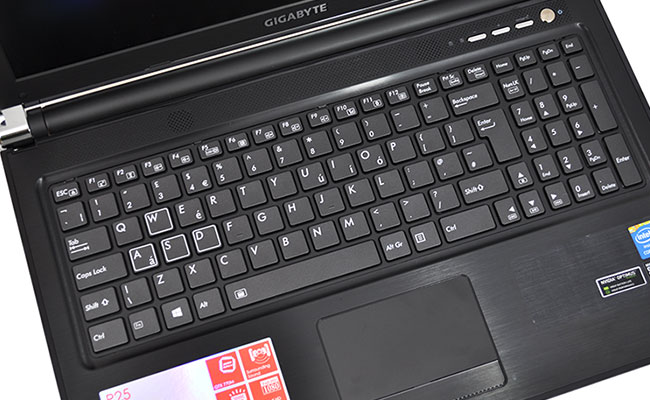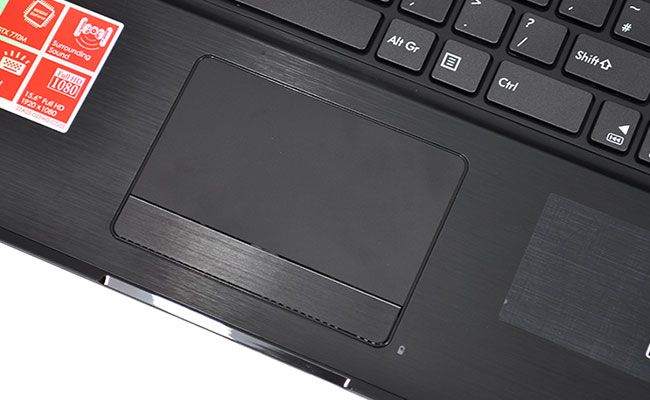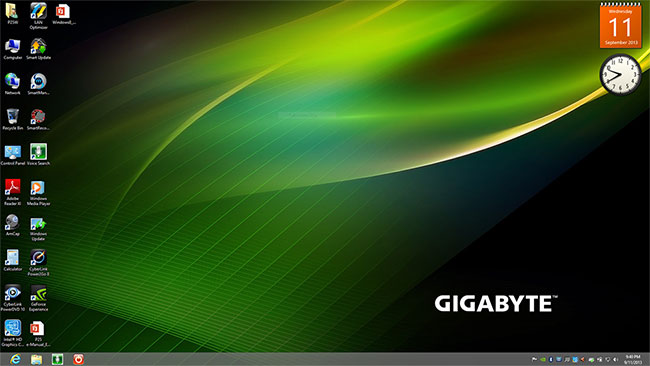Keyboard and Trackpad
The P25W has demonstrated various plus points thus far, and you can go ahead and add the keyboard to that list, too. The board makes good use of the chassis' size by including a dedicated numpad and keyboard layout is well-thought-out.
We like the fact that Ctrl is kept to the left of the Function key, and everything just feels as though it's in the right place. Double-height Enter, easily-accessible home, end and page keys, and a good selection of multimedia shortcuts across the top. This is a good panel for productivity - we've certainly enjoyed typing this review on it - and there are obvious nods toward gaming use. The WASD cluster is made to stand out, and the often troublesome Windows key can be fully disabled through software.
The keys themselves are a nice size with a good amount of spacing, and there's enough spring to prevent any feeling of mushiness. Finishing it off rather nicely, the entire panel is backlit with white LEDs that offer two levels of brightness.
We suspect most gamers will be using a dedicated external mouse, but for the occasions where you do have to revert to the trackpad, you needn't worry. Gigabyte's pointing device is well-sized, with buttons that offer a satisfying tactile click, and the surface itself is responsive and reacts well to gestures. Pinch-to-zoom and scrolling work as expected, and the trackpad's defined edges make it easy to swipe in from the sides during Windows 8 navigation.
The only criticism here isn't a hardware issue, it's the stickers that Gigabyte continues to apply wherever there's room. Sure, they're easily removed, but the stickers make the laptop look cheap and aren't befitting a premium machine such as this.
Software
Clearing up software clutter is on the to-do list for many a laptop manufacturer, and Gigabyte appears to be paying attention as the P25W's 64-bit Windows 8 installation is surprisingly clean.
Granted, the shortcuts on the desktop don't look pretty, but to be fair to Gigabyte, there's little in the form of bloatware. A lot of what's on offer is designed to help ease the transition from Windows 7 to Windows 8 - including a dedicated shutdown shortcut on the taskbar, as well as desktop shortcuts to Windows Media Player and Windows update.
It's interesting to see that Gigabyte has bought the old Windows Sidebar out of retirement - interesting because Microsoft itself dropped the feature in Windows 8 citing "serious vulnerabilities" - but that's about the only real question mark.
Elsewhere, there's no third-party anti-virus, as Gigabyte has chosen to stick with Windows 8's built-in security, and there are only a handful of noteworthy programs installed. These include CyberLink PowerDVD and Gigabyte's SmartUpdate and SmartManager utilities. The former makes it easy to find the latest applicable drivers/BIOS, while the latter provides on-screen shortcuts to popular settings such as display brightness, flight mode and touchpad on/off.
Heat and Noise
The biggest challenge for the P25W is keeping the high-performance CPU and GPU components running cool under load. Gigabyte has chosen to use the lesser GTX 765M in many other recent P-Series solutions, but the decision to go with the quicker GTX 770M suggests that the P25W chassis is able meet the thermal requirements of such hardware.
In practise, however, we've experienced mixed results. It takes only a small amount of load, on either processor, for the fans to kick into life and turn noisy. We appreciate the fact that there's a gentle curve - the fans don't just go from quiet to full-blast - but there's no ignoring the fact that the laptop can and will get loud.
What's interesting is that it's the Haswell CPU that's proving hot to handle. When running our CPU-intensive benchmarks for prolonged periods of time, we found that core temperature would rise up to 90ºC, causing the 3.4GHz chip to dial down to a more-conservative 2.8GHz. The Nvidia GPU, on the other hand, proved able and willing to GPU Boost up to 862MHz in most games, with temperature keeping below 65ºC.












